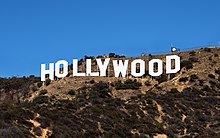
Back Cine estausunidense AN السينما في الولايات المتحدة Arabic ABŞ kinematoqrafiyası Azerbaijani Кино на САЩ Bulgarian মার্কিন যুক্তরাষ্ট্রের চলচ্চিত্র Bengali/Bangla Cinema dels Estats Units Catalan سینەمای ویلایەتە یەکگرتووەکان (ھۆڵیوود) CKB Ffilm yn yr Unol Daleithiau Welsh US-amerikanischer Film German Αμερικανικός κινηματογράφος Greek
| Cinema of the United States (Hollywood)  | |
|---|---|
 The Hollywood Sign in the Hollywood Hills, often regarded as the symbol of the American film industry | |
| No. of screens | 40,393 (2017)[1] |
| • Per capita | 14 per 100,000 (2017)[1] |
| Main distributors | |
| Produced feature films (2016)[2] | |
| Fictional | 646 (98.5%) |
| Animated | 10 (1.5%) |
| Number of admissions (2017)[4] | |
| Total | 1,239,742,550 |
| • Per capita | 3.9 (2010)[3] |
| Gross box office (2017)[4] | |
| Total | $11.1 billion |
| This article is part of a series on the |
| Culture of the United States |
|---|
 |
| Society |
| Arts and literature |
| Other |
| Symbols |
| By Region |
|
United States portal |
The cinema of the United States, primarily associated with major film studios collectively referred to as Hollywood, has significantly influenced the global film industry since the early 20th century.
Classical Hollywood cinema, a filmmaking style developed in the 1910s, continues to shape many American films today. While French filmmakers Auguste and Louis Lumière are often credited with modern cinema's origins,[5] American filmmaking quickly rose to global dominance. As of 2017, more than 600 English-language films were released annually in the U.S., making it the fourth-largest producer of films, trailing only India, Japan, and China.[6] Although the United Kingdom, Canada, Australia, and New Zealand also produce English-language films, they are not directly part of the Hollywood system. Due to this global reach, Hollywood is frequently regarded as a transnational cinema[7] with some films released in multiple language versions, such as Spanish and French.
Contemporary Hollywood frequently outsources production to countries including the United Kingdom, Canada, Australia, and New Zealand. The five major film studios—Universal Pictures, Paramount Pictures, Warner Bros., Walt Disney Studios, and Sony Pictures—are media conglomerates that dominate U.S. box office revenue and have produced some of the most commercially successful film and television programs worldwide.[8][9]
In 1894, the world's first commercial motion-picture exhibition was held in New York City using Thomas Edison's kinetoscope[10] and kinetograph.[11] In the following decades, the production of silent films greatly expanded. New studios formed, migrated to California, and began to create longer films. The United States produced the world's first sync-sound musical film, The Jazz Singer in 1927,[12] and was at the forefront of sound-film development in the following decades.
Since the early 20th century, the U.S. film industry has primarily been based in and around the thirty-mile zone, centered in the Hollywood neighborhood of Los Angeles County, California. The director D. W. Griffith was central to the development of a film grammar. Orson Welles's Citizen Kane (1941) is frequently cited in critics' polls as the greatest film of all time.[13] Hollywood is widely regarded as the oldest hub of the film industry, where most of the earliest studios and production companies originated, and is the birthplace of numerous cinematic genres.[14]
- ^ a b "Table 8: Cinema Infrastructure—Capacity". UNESCO Institute for Statistics. Archived from the original on December 24, 2018. Retrieved November 5, 2013.
- ^ "Table 1: Feature Film Production—Genre/Method of Shooting". UNESCO Institute for Statistics. Archived from the original on December 24, 2018. Retrieved May 30, 2019.
- ^ "Cinema—Admissions per capita". Screen Australia. Archived from the original on November 9, 2013. Retrieved November 9, 2013.
- ^ a b "Table 11: Exhibition—Admissions & Gross Box Office (GBO)". UNESCO Institute for Statistics. Archived from the original on December 24, 2018. Retrieved May 30, 2019.
- ^ "The Lumière Brothers, Pioneers of Cinema". History Channel. Retrieved January 15, 2017.
- ^ UIS. "UIS Statistics". data.uis.unesco.org.
- ^ Hudson, Dale. Vampires, Race, and Transnational Hollywoods. Edinburgh University Press, 2017. Website Archived December 22, 2019, at the Wayback Machine
- ^ Kerrigan, Finola (2010). Film Marketing. Oxford: Butterworth-Heinemann. p. 18. ISBN 9780750686839. Retrieved February 4, 2022.
- ^ Davis, Glyn; Dickinson, Kay; Patti, Lisa; Villarejo, Amy (2015). Film Studies: A Global Introduction. Abingdon: Routledge. p. 299. ISBN 9781317623380.
- ^ Billboard. Nielsen Business Media. April 29, 1944. p. 68. ISSN 0006-2510.
- ^ History.com Editors (February 9, 2010). "Thomas Edison patents the Kinetograph". HISTORY. Retrieved November 14, 2024.
- ^ "Why Contemporary Commentators Missed the Point With 'The Jazz Singer'". Time.
- ^ Village Voice: 100 Best Films of the 20th century (2001) Archived March 31, 2014, at the Wayback Machine. Filmsite.org; "Sight and Sound Top Ten Poll 2002". BFI. Archived from the original on May 15, 2012. Retrieved June 19, 2007.
- ^ Rosenstone, Robert A. (1985). Schatz, Thomas; Isenberg, Michael T.; Roffman, Peter; Purdy, Jim; Cavell, Stanley; Alexander, William (eds.). "Genres, History, and Hollywood. A Review Article". Comparative Studies in Society and History. 27 (2): 367–375. doi:10.1017/S0010417500011427. ISSN 0010-4175. JSTOR 178501.